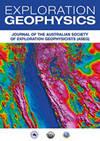Advanced magnetic survey system and method for detailed magnetic field mapping near the sea bottom using an autonomous underwater vehicle
IF 0.8
4区 地球科学
Q4 GEOCHEMISTRY & GEOPHYSICS
引用次数: 3
Abstract
Marine magnetic field surveys conducted near the sea bottom are useful in producing images of the oceanic crust in order to ascertain its volcanic eruption history, active hydrothermal systems, and hydrothermal deposit evolution. An autonomous underwater vehicle (AUV) can carry out self-controlled survey operations while maintaining a stable vehicle attitude at low altitudes above the seafloor. As a result of these benefits, AUVs have attracted attention for various missions. The total magnetic field intensity is generally used for subsurface magnetization images. Recently, vector magnetic anomaly analysis has been considered to be extremely effective for high-accuracy estimation of subsurface magnetization structures. However, correcting for the anomalous magnetic field produced by the vehicle body is one of the difficulties that hinders vector magnetic anomaly analysis. Therefore, we developed a magnetometer system designed for the AUV URASHIMA with a renewed navigation data distribution system. Experimental observation was carried out around a submarine mud volcano with a small magnetic anomaly off Tanegashima Island. The results show that correction for the magnetic field of the vehicle because of the attitude, especially for changes in pitch, is essential for near-bottom magnetic surveys using AUVs. Based on these results, we proposed a suitable data acquisition method to remove the pitching effects of the vehicle for figure-eight turns. Next, practical observation was carried out in the hydrothermal area, and the proposed correction method for magnetic data reduced the pitch variation effect. These results indicate that the correction for the magnetic field of the vehicle based using attitude data, especially for pitching variations, is required in order to obtain high-quality magnetic anomaly data using AUVs. However, a short-period variation of approximately 10 nT caused by abrupt pitch changes remains.使用自主水下航行器绘制海底附近详细磁场图的先进磁测量系统和方法
在海底附近进行的海洋磁场调查有助于生成海洋地壳的图像,以确定其火山喷发历史、活跃的热液系统和热液矿床的演化。自主水下航行器(AUV)可以在海底低海拔保持稳定的航行器姿态的同时进行自主探测操作。由于这些优势,AUV在各种任务中都引起了人们的关注。总磁场强度通常用于地下磁化图像。最近,矢量磁异常分析被认为是非常有效的地下磁化结构的高精度估计。然而,校正车身产生的异常磁场是阻碍矢量磁异常分析的难点之一。因此,我们开发了一个为URASHIMA AUV设计的磁力计系统,并更新了导航数据分配系统。实验观测是在种子岛附近一座有小磁异常的海底泥火山周围进行的。结果表明,由于姿态的变化,特别是俯仰的变化,对飞行器磁场的校正对于使用AUV的近底磁测量至关重要。基于这些结果,我们提出了一种合适的数据采集方法,以消除车辆在8字形转弯时的俯仰效应。接下来,在热液区进行了实际观测,提出的磁数据校正方法降低了间距变化的影响。这些结果表明,为了使用AUV获得高质量的磁异常数据,需要使用姿态数据对飞行器的磁场进行校正,特别是对俯仰变化的校正。然而,由突然的音调变化引起的大约10nT的短周期变化仍然存在。
本文章由计算机程序翻译,如有差异,请以英文原文为准。
求助全文
约1分钟内获得全文
求助全文
来源期刊

Exploration Geophysics
地学-地球化学与地球物理
CiteScore
2.30
自引率
0.00%
发文量
33
审稿时长
>12 weeks
期刊介绍:
Exploration Geophysics is published on behalf of the Australian Society of Exploration Geophysicists (ASEG), Society of Exploration Geophysics of Japan (SEGJ), and Korean Society of Earth and Exploration Geophysicists (KSEG).
The journal presents significant case histories, advances in data interpretation, and theoretical developments resulting from original research in exploration and applied geophysics. Papers that may have implications for field practice in Australia, even if they report work from other continents, will be welcome. ´Exploration and applied geophysics´ will be interpreted broadly by the editors, so that geotechnical and environmental studies are by no means precluded.
Papers are expected to be of a high standard. Exploration Geophysics uses an international pool of reviewers drawn from industry and academic authorities as selected by the editorial panel.
The journal provides a common meeting ground for geophysicists active in either field studies or basic research.
 求助内容:
求助内容: 应助结果提醒方式:
应助结果提醒方式:


